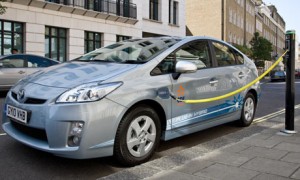Suppose you one of those people who has to have a car to do the short trips — to the newspaper shop, to school, to the local library, to the station even. Now there’s a very low-cost electric powered driving option available. And if you generate your own power, it’s effectively free, if you discount the energy expended in building and maintaining the car.
The Guardian’s Adam Vaughan test drove the latest Prius, a plug-in hybrid electric vehicle (PHEV), and asked: “is this the future of greener motoring?” http://www.guardian.co.uk/environment/green-living-blog/2010/sep/06/test-driving-plug-in-prius. Like Toyota’s standard hybrids, it runs on both a petrol engine and electric motor. But you can plug it into the mains for a charge too.
That’s enough for about 13 miles. Then the petrol engine cuts in. So drivers don’t suffer from the “range anxiety” that bothers electric cars.
Vaughan points out that even the much anticipated Nissan Leaf only does 100 miles on a charge. Government studies suggest electric cars emit 40% less Co2 than the petrol equivalent, even when the electricity is drawn from the UK’s fossil fuel-heavy power stations. An “electric mile” costs about 2p. A petrol powered mile is about 14p. So making those short of local trips on electric charge would bring big savings.
He did some some errands in electric-only mode before setting off on a long drive – the petrol engine and hybrid battery kicked in automatically. On the way back he popped into the massive Westfield shopping centre in West London. It has 30 electric car charging points, the most in the UK after the 100 at the Highcross Centre in Leicester.
The battery was topped up for free in an hour and a half.We are promised thousands of recharging points in public places around the country under the government’s plugged-in places scheme.
Let’s see if this survives the comprehensive spending review, to be announced on 20 October.
Expect to see a lot more of these cars on the road soon. HSBC predicted this week (September 2010) that 8.65m electric vehicles and 9.23m plug-in and hybrid electric vehicles will be sold globally in 2020. In the short term the Royal Academy of Engineering thinks plug-ins are a likely alternative to the problems faced by fully electric cars (concern about the battery life, and range anxiety.)

